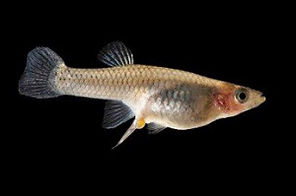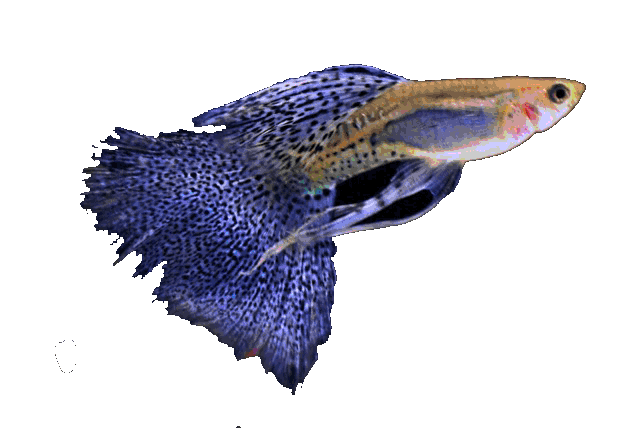
Reproductive strategies of fish Thierry Lode (2012)
We know four basic ways in sexual reproduction in fish.
Ovuliparity
Oviparity - oviparity (lat. ovum: egg + parere: to give birth)
Ovoviviparity - ovoviviparity (lat. ovum: egg + viviparus: viviparous)
Viviparity - viviparity (lat. viviparus - alive)
1. Ovuliparity
Most Cyprinodontiformes use this method of reproduction, the female releases eggs into the environment (Figure A)
(substrate, rocks, plants, nests, pits, etc., depending on the species), where they are also fertilized.
The embryo feeds on its own food supply (egg yolk). From the eggs or eggs (Fig. B), a larva (Fig. C) develops, which develops and feeds on the egg yolk for a few more days. After a few days, the pup is independent and begins to feed itself.




2. Oviparity
In this mode, fertilization is internal, which means that the sperm comes into contact with the eggs inside the female, where they are fertilized.
Males use a series of transformed dorsal fins (intromittent organ) to achieve the goal.
After this process, the female lays her eggs in the environment, this can happen immediately or after a certain time.
A very rare species in fish, Tomeurus gracilis is one of the species that reproduces in this way.
Both of these cases are characterized by a large number of young, especially in species that lay eggs freely in the environment or species that take care of their offspring in one way or another.
There are several groups with this reproduction:
(A) Fish spawning in pairs or groups are laid by females and males at the same time
eggs and sperm into the water where fertilization occurs, the eggs are carried away by the current or simply
sink to the bottom among plants or rocks. It is characterized by a large number of eggs,
the disadvantage is that the young go through the larval stage and are very much then
vulnerable (predators), the survival rate is very low.
(B) Fish that lay eggs flat
surfaces (stones, plant leaves and
similar). They spawn in pairs and
they usually keep eggs and then
pups in danger.
This includes many perch,
catfish and rainbow trout.


(C) Fish that build nests. Either
a pit in the sand or a floating nest
from bubbles. The male takes care of the nest
and keeps eggs. This includes labyrinths
and some catfish.


(D) Carnivores, spawning fish and fry
kept in the muzzle. Female eggs usually
place on a flat surface or pit where
the male fertilizes them, after that the female spawns
picks up in the muzzle. The survival rate is
very large soot when the pups leave
mothers are quite large and independent.
Known fish of this group are perch from
African lakes.


(E) "Killi fish" reproduce in an interesting way, in a period of drought when the temperature rises, the fish lay their eggs on the muddy bottom of the floodplains before they dry out completely, the fish die and the eggs in the mud are safely waiting for the next rainfall to fill the troughs again. for the birth of new life begins. The eggs can survive for many years in the mud.
--------------------------------------------------- --------------------------------------------------- --------
The following two methods take care to protect the embryos during development inside the female. This includes live births.
3. Ovoviviparity
After the process of internal fertilization, the eggs are not released and remain protected from external influences in the body of the female, where they remain throughout the developmental process until they hatch.
Embryos are fed with their own supply of food in the egg (egg yolk), which is their only source of nutrition, the embryos are allowed to breathe, excrete and osmoregulate. In females, the walls of the ovaries expand considerably during embryonic development and are richly equipped with blood vessels. These include lecithotrophic live births (by diet).
Fish of the family Poeciliidae are known for this mode of reproduction.



4. Viviparity
There are two types of viviparation:
(A) Histotrophic (this includes most freshwater beaked pike and freshwater whips), (in the uterus epithelial cells secrete a special milk substance that serves as food - histotroph) Video Dermogenys pusilla
(B) Hemotrophic (this includes live-bearing Mexican carp, the family is characterized by the connection of the embryo with the mother with trophotenia (trophe - nutrients, taenia - bond), which acts similarly to the placenta / placenta in mammals)
Here, too, there is internal fertilization, but the exchange of metabolites is taken care of, including the nutrition of the embryo (includes the transfer of antibodies against diseases), oxygen supply, ...
During the developmental process of embryos, the female organism changes considerably, from an increase in the size of the uterus, changes in circulation, endocrine glands (endocrine glands-hormones), gastrointestinal tract
(gastrointestinal tract system), etc.
In these two ways, the number of pups is much smaller. However, embryos are safer and the probability of survival is high.
The pups are independent and fully developed immediately after birth.
In the case of live birth, we know a specialty called superfetation, here there are several simultaneous offspring at different stages of development.
Females of this species also have the ability to store sperm in the folds of the ovaries for up to seven months.
This allows them up to 8 or 9 consecutive litters in the absence of males.





Anableps
Nomorhamphus




